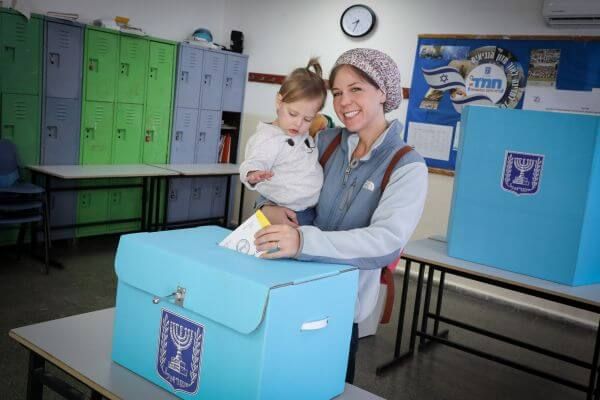Israeli elections always generate media interest. As Israeli society tries to strike a balance between being Jewish, democratic and secure, ongoing developments always seem to make Israel a lightning rod for criticism, kudos and consuming conversation.
If you’re trying to make sense of the Israeli elections and related domestic politics, here’s the basic background you need to know about the voting process and how a governing coalition is formed.
There are two primary stages to the process which will be elaborated on below.
- The Knesset is formed based on the election results.
- One of the party leaders puts together a governing coalition.
Join the fight for Israel’s fair coverage in the news
Who gets a Knesset seat?
1. Israel’s parliament, the Knesset, has 120 seats. Members of Knesset (MKs) are chosen based on proportional representation, not by district. If a party receives, say, 10 percent of the vote, that party will receive 12 of the seats. When parties register to run, they list their slate of candidates so the public can know who the lawmakers would be. Voters cast their ballots for a party, not for an individual candidate.
2. Israeli elections are held every four years, or earlier if the governing coalition is dissolved. By law, Israel cannot go for more than four years without elections. Votes of no-confidence or the failure to pass a budget by a certain date, among other things, can force the Knesset’s dissolution.
3. Israeli citizens 18 and older are eligible to vote. Palestinians living in the West Bank and Gaza vote in Palestinian Authority elections. Palestinians with Jerusalem residency permits can vote in municipal elections, but not in national elections. With divided leadership between Gaza and the West Bank, the Palestinian Authority and Hamas have been unable or unwilling to hold elections of their own. (Related reading: So Why Can’t the Palestinians Vote?)
4. The voting process is low-tech indeed: Voters stand behind a partition, choose a slip of paper with the name of their party and put it in an envelope. In front of Central Elections Committee volunteers, voters place their envelope in a blue box. After polls close, the votes are counted and the results are made public. (Related reading: Here’s What Israeli Democracy in Action Looks Like)

5. Parties must receive a minimum of 3.25 percent of the vote (the equivalent of four Knesset seats) to sit in the parliament. Votes for parties that don’t make that threshold are known as wasted votes. The minimum threshold was raised several times in recent years to streamline Knesset activities by keeping smaller factions out of parliament. (For a fuller discussion on this issue and its implications, see the Israel Policy Forum and the Israel Democracy Institute.)
Related reading: So Why Can’t the Palestinians Vote?
6. Ahead of the Israeli elections, parties can make “surplus vote” deals with other each other in the hopes of gaining extra seats. Ynet explains how they work:
After the polls close, the votes are counted and each party that makes it past the threshold is allocated a number of the 120 Knesset seats depending on the percentage of the vote they received. However, it is rarely a tidy number, and there is normally a number of votes for each party that do not translate into a full Knesset seat. And this is where a party can boost its number of seats, if it manages to strike a deal with another party for surplus votes.
Two parties can use the surplus votes agreement to combine their leftover ballots, and if the two combined totals adds up to enough votes to make a full seat, it then goes to the party with the greater number of surplus votes (which most of the time is also the bigger party).
These agreements — also known as “vote sharing” — are publicized before the elections. (To learn more about the methodology behind the surplus vote calculations, see The Distribution of Knesset Seats Among the Lists – the Bader-Offer Method at the Knesset’s web site.)
7. In the history of Israeli elections, no party has ever won 61 Knesset seats, so governing requires a coalition.
Related reading: The Chaos of Israeli Democracy: An Explainer
Creating a coalition

8. After all the Knesset seats are allocated, Israel’s President holds consultations with the leaders of all the parties to gauge who would have the best chance of forming a coalition. A governing coalition technically requires a simple majority of 61 MKs, but larger coalitions have more stability. If a national unity government is to emerge, this is the stage it will become evident. Israel’s current President is Reuven Rivlin.
9. After holding consultations, the President will choose the party leader he feels has the best chance of forming a coalition. Heading the party with the most Knesset seats doesn’t automatically mean that person will become prime minister. For example, Tzipi Livni’s Kadima Party won more seats than Likud in the 2009 elections, but the make-up of the Knesset and resulting consultations led president Shimon Peres to assign Benjamin Netanyahu with the job.
10. Once tasked with building a governing a coalition, the would-be prime minister has 28 days to pull it off. It’s a time of horse-trading — the would-be PM has to satisfy competing demands for cabinet appointments, policy commitments and political principles among potential coalition partners and within his own party. Because of all the wheeling and dealing, the president customarily grants the would-be prime minister a 14-day extension if necessary.
Related video: Video: What You Didn’t Know About Israeli Elections
11. If the would-be PM fails to form a governing coalition in time, the president will ask a second candidate to form one in 28 days. Should that fail, a third candidate would be given a chance in 14 days. (Neither would have any possibility of receiving a extension.) Should all three candidates fail to form a coalition, the president will dissolve the Knesset, new elections will be held within 90 days, and the process of Israeli elections repeats itself. That situation has never materialized, although the Knesset was dissolved in spring 2019 without a coalition being formed by incumbent Benjamin Netanyahu, but before rival candidates were given the chance to form a coalition.
12. Once a coalition is agreed upon, the would-be prime minister presents to the Knesset a report listing the cabinet ministers and sketching out the government’s basic policies. After MKs vote to confirm the new government, the prime minister and the cabinet are sworn in and begin governing.
Liked this article? Follow HonestReporting on Twitter, Facebook, Instagram and TikTok to see even more posts and videos debunking news bias and smears, as well as other content explaining what’s really going on in Israel and the region.
Before you comment on this article, please note our Comments Policy. Any comments deemed to be in breach of the policy will be removed at the editor’s discretion.


